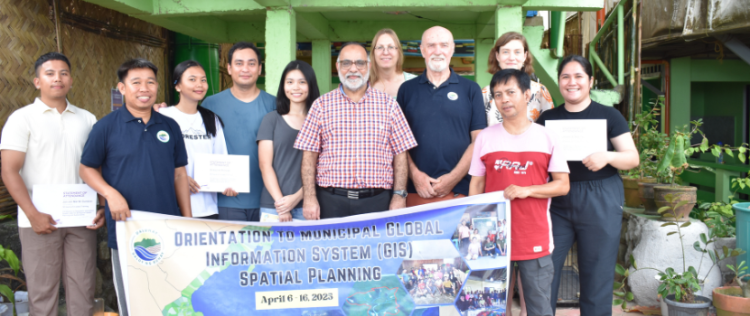From the sea surrounding the Philippines to the forests of Northern Saskatchewan, Saskatchewan Polytechnic researchers have collaborated with partners to develop tools for mapping and resource management through an international project funded by the Government of Canada's New Frontiers in Research Fund (NFRF). Over the past two years, Sask Polytech's Sustainability-Led Integrated Centres of Excellence (SLICE) researchers have been collecting data and training community members in the Philippines and Saskatchewan through partnerships with Daluhay, a Filipino non-governmental organization, and Prince Albert Model Forest.
Sask Polytech was the first polytechnic institution to be awarded funding by the NFRF for an international project.
"It's a highly competitive program and highly prestigious. This funding is a reflection of what we bring to the table and what we bring as a polytechnic," says Dr. Robin Smith, SLICE director. "It has expanded the horizons of what we're doing and what we can foresee doing, so that's really exciting."

SLICE research chair Dr. Abdul Raouf says the project focused on the creation of a series of small-scale demonstration projects using Geographic Information Systems (GIS) and remote sensing technologies to showcase their potential as tools for sustainable development, improving climate change resilience. The goal was to help position Indigenous communities in Saskatchewan and the Philippines to contribute to environmental policy and program initiatives at regional, national and international levels. Through engaging with these partners, he says the project evolved.
"The number of deliverables we developed kept increasing. That's a big success. Collaborators were excited to see their data at work," he says.
Through the partnerships, researchers applied the use of technologies to each environment, from the tropics of the Philippines to the boreal forests of Saskatchewan.
"Seeing the partners' needs, how they might be the same, how they may be different and working with Indigenous community partners in both jurisdictions has been a culturally rich experience," says Smith.
"The underlying themes of sustainability, biodiversity and food sovereignty were common interests and priorities in both jurisdictions." The team travelled to the Philippines last April as part of the research project to develop a GIS hub in Aurora province. During the trip, they met with representatives from different regional communities and organizations, including government agencies and academic institutes. They engaged the local communities through knowledge-sharing workshops, connecting with more than 100 people. They also provided training to nine Daluhay staff members on the use and long-term maintenance of GIS technologies.
"Once the hub is developed somebody needs to sustain it, look after it and keep working on it," Raouf says.
The thematic focus in the Philippines was to provide tools to manage marine resources and improve resource management for food security by creating digital interactive maps and dashboards.
"Marine life is a big part of the food source in the Philippines. Mapping the coastal surface area is not enough. You need to calculate the volume of the coastal waters for a better understanding of the available resources and their management," Raouf says.
On the other side of the globe, the Prince Albert Model Forest research focused on the boreal forest. Remote sensing technologies were used for temporal analysis of the selected areas to monitor forest regrowth and its health after logging operations, wildfires or other disturbances. The digital and interactive dashboards created through the project are efficient information tools allowing community leaders, resource managers and policy makers to access accurate land-use and land-cover information with just one click.
Raouf says. "Anything that can be measured can be managed."
Community advisory committees were vital in the research process. The representatives helped guide the work through quarterly meetings. Their knowledge was integrated into story maps to share information, stories and history in a compelling way.
"Culture needs to be preserved and our oral stories need to be preserved in a format which can resonate with a younger generation more prone to using digital tools," Raouf says.
The researchers are in the final stages of the project as funding ends in January 2026. They are meeting with community advisory committees to discuss the next steps. The research team is currently applying to secure funding for future endeavors with Daluhay and Prince Albert Model Forest.
SLICE is based in Sask Polytech's Faculty of Technology and Skilled Trades. SLICE's vision is to advance sustainability in Saskatchewan and beyond through collaborative applied research for the benefit of our economy, environment, society and future generations.
Learn more about applied research at saskpolytech.ca/research.
Saskatchewan Polytechnic is signatory to the SDG Accord. Sustainable Development Goal alignment is one of the ways Sask Polytech is leading the rise of polytechnic education.













